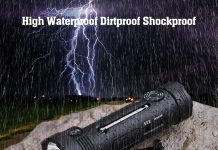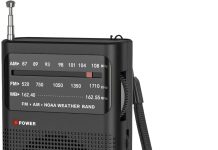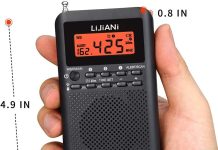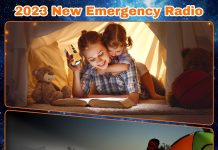Imagine being in the midst of a disaster, cut off from the outside world, desperately seeking updates and information. In such situations, emergency radios can be a lifeline, providing crucial information when other forms of communication fail. But have you ever wondered if these radios are useful for disasters other than storms? This article explores the versatility of emergency radios in various disaster scenarios, highlighting their ability to provide vital information and potentially save lives. So, let’s unravel the potential of these invaluable devices and discover their significance beyond storms.
Review contents
Emergency Radios: A Versatile Tool in Disasters
Introduction
Emergency radios play a crucial role in providing communication and information during times of crisis. While they are commonly known for their effectiveness during storms, they are also incredibly useful in a wide range of other disasters. Understanding the role of emergency radios and their benefits in various emergency situations is essential for disaster preparedness. In this article, we will delve into the functionality and features of emergency radios, and explore how they can be beneficial in situations such as bushfires, earthquakes, floods, tornadoes, avalanches, nuclear incidents, chemical spills, terrorist attacks, pandemics, and other disasters.
Understanding the Role of Emergency Radios
Emergency radios, also known as survival radios or weather radios, are portable devices specifically designed to receive and transmit important information during emergencies. These radios are equipped with multiple features that enable users to stay informed and connected even when traditional communication channels are disrupted. In disaster situations, communication becomes a critical lifeline, providing guidance, updates, and coordination among various emergency response teams and affected individuals. Emergency radios serve as a reliable means of receiving crucial information that can save lives and facilitate effective disaster management.
To effectively utilize emergency radios, it is important to familiarize yourself with their functionality and features. These radios are typically equipped with AM/FM receivers, weather band channels (such as NOAA Weather Radio), and Shortwave bands to receive broadcasts from a range of sources. Some advanced models also include features such as LED flashlights, power banks for charging other devices, and built-in sirens for emergency alerts. Having a reliable power source is crucial for emergency radios to ensure continuous functionality. Many models offer a combination of battery-powered, solar-powered, and hand-crank charging options, enabling users to stay connected even in situations where electricity is unavailable.
Benefits of Emergency Radios in Disasters
Emergency radios provide numerous benefits in a variety of disaster scenarios. Let’s explore some of the key benefits and their applications in different types of emergencies:
1. Bushfires and Wildfires
1.1 Ensuring Communication in Remote Areas
During bushfires and wildfires, communication can be challenging in remote areas where traditional infrastructure may be severely affected. Emergency radios allow individuals and emergency services to establish communication channels, enhancing coordination and rescue efforts.
1.2 Monitoring Fire Updates and Evacuation Orders
Emergency radios provide real-time updates on fire conditions, evacuation orders, and the spread of the fire, helping individuals make informed decisions and take appropriate actions to stay safe.
1.3 Assisting Emergency Services Coordination
Emergency radios enable emergency services to relay important information to volunteers, firefighters, and other response teams, ensuring efficient coordination and resource allocation.
2. Earthquakes
2.1 Early Warning System
Some advanced emergency radios are capable of receiving earthquake early warning alerts, providing individuals with vital seconds or minutes to take cover and protect themselves before the shaking begins.
2.2 Search and Rescue Operations
After an earthquake, emergency radios play a crucial role in search and rescue operations by facilitating communication between trapped individuals and rescue teams, ultimately increasing the chances of survival.
2.3 Communication Restoration
During earthquakes, telecommunication networks may be disrupted. Emergency radios provide a reliable means of communication, facilitating information exchange among affected individuals, relief workers, and emergency services.
3. Floods
3.1 Real-time Updates on Rising Water Levels
Emergency radios equipped with weather band channels can receive real-time updates on rising water levels, enabling individuals to evacuate promptly and avoid dangerous situations.
3.2 Coordination of Evacuation Efforts
Emergency radios allow emergency management agencies to coordinate evacuation efforts, providing directions and updates to affected communities, and ensuring a smooth and organized evacuation process.
3.3 Safety Instructions and Information
During floods, emergency radios broadcast safety instructions, such as avoiding contaminated water, locating emergency shelters, and providing information on post-flood assistance and recovery efforts.
4. Tornadoes
4.1 Monitoring Severe Weather Warnings
Emergency radios are equipped with weather band channels that enable users to receive severe weather warnings issued by meteorological authorities, helping individuals take immediate shelter and prepare for impending tornadoes.
4.2 Relaying Public Safety Information
In the aftermath of a tornado, emergency radios serve as an efficient means of communicating public safety information, such as road closures, safe routes, and assistance centers, enabling affected individuals to navigate the aftermath safely.
4.3 Assisting Emergency Response Teams
Emergency radios play a vital role in assisting emergency response teams by relaying information about survivors, locations, and emerging needs, streamlining rescue and relief efforts.
5. Avalanches
5.1 Avalanche Warnings and Avoidance
In avalanche-prone areas, emergency radios provide crucial avalanche warnings and safety information, allowing individuals to avoid high-risk areas and take necessary precautions.
5.2 Communication in Remote and Isolated Areas
Avalanche incidents often occur in remote and isolated regions where traditional communication infrastructure may be limited. Emergency radios provide a means of communication, allowing individuals to seek assistance or inform rescue teams immediately.
5.3 Coordinating Search and Rescue Operations
During avalanches, emergency radios facilitate coordination among search and rescue teams, enhancing efficiency and reducing response time, which is crucial in saving lives.
6. Nuclear Incidents
6.1 Emergency Evacuation Orders and Instructions
In the event of a nuclear incident, emergency radios transmit timely evacuation orders and instructions, enabling individuals to evacuate safely and minimize exposure to dangerous radiation levels.
6.2 Information on Radiation Levels and Containment Efforts
Emergency radios provide updates on radiation levels, containment efforts, and recommendations for protective measures, assisting individuals in making informed decisions to safeguard their health.
6.3 Updates from Nuclear Regulatory Authorities
Government agencies and nuclear regulatory authorities use emergency radios to broadcast updates and information regarding the status of a nuclear incident, ensuring transparency and public awareness.
7. Chemical Spills
7.1 Hazardous Material Safety Precautions
Emergency radios broadcast safety precautions and instructions for dealing with chemical spills, offering essential guidance to affected individuals and emergency response teams.
7.2 Information on Contamination Zones
During chemical spills, emergency radios provide information on contamination zones, allowing individuals to take necessary precautions and avoid hazardous areas.
7.3 Updates on Cleanup and Mitigation
Emergency radios provide updates on cleanup and mitigation efforts following a chemical spill, helping affected communities stay informed and aware of progress in containment and recovery operations.
8. Terrorist Attacks
8.1 Emergency Alerts and Public Safety Information
Emergency radios play a critical role in broadcasting emergency alerts and public safety information during terrorist attacks, ensuring that affected individuals receive timely and accurate information.
8.2 Guidance on Sheltering in Place or Evacuating
During a terrorist attack, emergency radios provide guidance on whether to shelter in place or evacuate, helping individuals make informed decisions and increase their chances of survival.
8.3 Reliable Communication amidst Network Overload
During a terrorist attack, the telecommunication network may become overloaded, hindering communication. Emergency radios offer a reliable means of communication, ensuring connectivity when it is most needed.
9. Pandemics and Health Emergencies
9.1 Dissemination of Health Guidelines and Precautions
Emergency radios serve as an effective medium for broadcasting health guidelines, precautionary measures, and updates during pandemics and health emergencies, helping individuals stay informed and follow necessary protocols.
9.2 Updates on Vaccine Distribution and Testing Centers
During public health emergencies, emergency radios provide updates on vaccine distribution locations, testing centers, availability, and other vital information, facilitating efficient healthcare delivery.
9.3 Facilitating Coordination among Medical Professionals
Emergency radios enable coordination among medical professionals, allowing them to exchange critical information, share resources, and collaborate effectively in response to public health crises.
10. Other Disasters
In addition to the aforementioned disasters, emergency radios are equally valuable in managing various other emergencies:
10.1 Landslides and Mudslides
Emergency radios provide real-time updates on landslide or mudslide warnings, evacuation orders, and coordination information, enhancing the safety and well-being of affected individuals.
10.2 Tsunamis
During tsunamis, emergency radios broadcast tsunami warnings, evacuation rules, and updates on affected areas, ensuring individuals at risk have the necessary information to seek higher ground and protect themselves.
10.3 Heatwaves and Droughts
Emergency radios provide updates on heatwave warnings, heat safety guidelines, and drought conditions, assisting individuals in taking necessary precautions and accessing support services.
10.4 Power Outages
During power outages, emergency radios become invaluable sources of information, providing updates on restoration efforts, local assistance centers, and safety instructions for using alternative sources of power.
10.5 Civil Unrest and Riots
Emergency radios can play a crucial role in disseminating public safety information, curfew orders, safe zones, and updates on the situation during civil unrest and riots, helping individuals stay informed and make informed decisions regarding their safety.
Conclusion
Emergency radios prove to be an indispensable tool in disaster management and preparedness. From bushfires and earthquakes to floods, tornadoes, avalanches, nuclear incidents, chemical spills, terrorist attacks, pandemics, and other disasters, their versatility and functionality make them an essential component of any emergency response plan. By ensuring reliable communication, providing vital updates, and aiding coordination efforts, emergency radios contribute significantly to minimizing casualties and increasing the effectiveness of emergency response operations. It is crucial to include emergency radios in disaster preparedness plans and regularly maintain them to ensure they are ready to serve when disasters strike. Remember, when it comes to emergencies, being informed can make all the difference in staying safe.




























